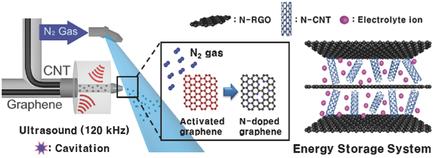当前位置:
X-MOL 学术
›
Adv. Mater.
›
论文详情
Our official English website, www.x-mol.net, welcomes your
feedback! (Note: you will need to create a separate account there.)
Carbon–Heteroatom Bond Formation by an Ultrasonic Chemical Reaction for Energy Storage Systems
Advanced Materials ( IF 27.4 ) Pub Date : 2017-11-09 , DOI: 10.1002/adma.201702747 Hyun-Tak Kim 1 , HyeonOh Shin 1 , In-Yup Jeon 2, 3 , Masood Yousaf 4 , Jaeyoon Baik 5 , Hae-Won Cheong 6 , Noejung Park 7 , Jong-Beom Baek 2 , Tae-Hyuk Kwon 1
Advanced Materials ( IF 27.4 ) Pub Date : 2017-11-09 , DOI: 10.1002/adma.201702747 Hyun-Tak Kim 1 , HyeonOh Shin 1 , In-Yup Jeon 2, 3 , Masood Yousaf 4 , Jaeyoon Baik 5 , Hae-Won Cheong 6 , Noejung Park 7 , Jong-Beom Baek 2 , Tae-Hyuk Kwon 1
Affiliation

|
The direct formation of CN and CO bonds from inert gases is essential for chemical/biological processes and energy storage systems. However, its application to carbon nanomaterials for improved energy storage remains technologically challenging. A simple and very fast method to form CN and CO bonds in reduced graphene oxide (RGO) and carbon nanotubes (CNTs) by an ultrasonic chemical reaction is described. Electrodes of nitrogen‐ or oxygen‐doped RGO (N‐RGO or O‐RGO, respectively) are fabricated via the fixation between N2 or O2 carrier gas molecules and ultrasonically activated RGO. The materials exhibit much higher capacitance after doping (133, 284, and 74 F g−1 for O‐RGO, N‐RGO, and RGO, respectively). Furthermore, the doped 2D RGO and 1D CNT materials are prepared by layer‐by‐layer deposition using ultrasonic spray to form 3D porous electrodes. These electrodes demonstrate very high specific capacitances (62.8 mF cm−2 and 621 F g−1 at 10 mV s−1 for N‐RGO/N‐CNT at 1:1, v/v), high cycling stability, and structural flexibility.
中文翻译:

超声化学反应在储能系统中形成碳-杂原子键
由惰性气体直接形成CN和CO键对于化学/生物过程和能量存储系统至关重要。然而,其在碳纳米材料上用于改善能量存储的应用在技术上仍然具有挑战性。描述了一种通过超声波化学反应在还原的氧化石墨烯(RGO)和碳纳米管(CNT)中形成CN和CO键的简单,快速的方法。氮或氧掺杂的RGO(分别为N-RGO或O-RGO)的电极是通过N 2或O 2载气分子与超声激活的RGO之间的固定来制造的。掺杂后材料表现出更高的电容(133、284和74 F g -1分别用于O‐RGO,N‐RGO和RGO)。此外,掺杂的2D RGO和1D CNT材料是通过使用超声波喷雾进行逐层沉积以形成3D多孔电极而制备的。这些电极显示出非常高的比电容(对于N‐RGO / N‐CNT 1:1,v / v,在10 mV s -1下为62.8 mF cm -2和621 F g -1),高循环稳定性和结构灵活性。
更新日期:2017-11-09
中文翻译:

超声化学反应在储能系统中形成碳-杂原子键
由惰性气体直接形成CN和CO键对于化学/生物过程和能量存储系统至关重要。然而,其在碳纳米材料上用于改善能量存储的应用在技术上仍然具有挑战性。描述了一种通过超声波化学反应在还原的氧化石墨烯(RGO)和碳纳米管(CNT)中形成CN和CO键的简单,快速的方法。氮或氧掺杂的RGO(分别为N-RGO或O-RGO)的电极是通过N 2或O 2载气分子与超声激活的RGO之间的固定来制造的。掺杂后材料表现出更高的电容(133、284和74 F g -1分别用于O‐RGO,N‐RGO和RGO)。此外,掺杂的2D RGO和1D CNT材料是通过使用超声波喷雾进行逐层沉积以形成3D多孔电极而制备的。这些电极显示出非常高的比电容(对于N‐RGO / N‐CNT 1:1,v / v,在10 mV s -1下为62.8 mF cm -2和621 F g -1),高循环稳定性和结构灵活性。











































 京公网安备 11010802027423号
京公网安备 11010802027423号